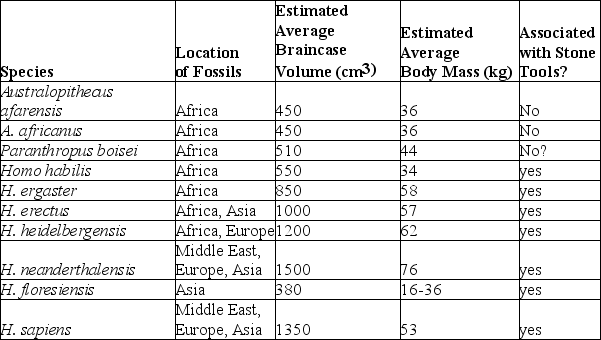Multiple Choice
Use the following information to answer the question.
Brown et al. and Morwood et al. reported in 2004 that they had found skeletal remains of a previously unknown type of hominin, now dubbed Homo floresiensis, on the Indonesian island of Flores. These hominins were small (approximately 1 meter tall) with small braincases (approximately 380 cubic centimeters) as compared with other hominins. The remains of H. floresiensis were found alongside handmade stone tools and the remains of dwarf elephants that also inhabited the island, suggesting that H. floresiensis was able both to make tools and to coordinate the hunting of animals much larger than itself. H. floresiensis is estimated to have lived at the site where the remains were found from at least 38,000 years ago to 18,000 years ago.
The table is a comparison of several characteristics of H. floresiensis to those of nine other hominin species (arranged roughly from oldest to most recent) . What do these data suggest?
A) A large brain is not necessarily required for toolmaking.
B) Body mass and braincase volume are completely unrelated.
C) Hominins first evolved in and then radiated out from Asia.
D) Homo floresiensis is most closely related to Australopithecus afarensis or A. africanus.
Correct Answer:

Verified
Correct Answer:
Verified
Q64: Ancient fossils that seem to be an
Q72: Scientific views are based on evidence rather
Q73: Birds are descended from species that laid
Q74: Suppose, while out camping in a forest,
Q75: It is believed that the coelacanths and
Q76: Which of the following is the most
Q77: Use the following figure and information to
Q78: Which of the following types of evidence
Q80: A trend first observed in the evolution
Q82: Use the following information to answer the